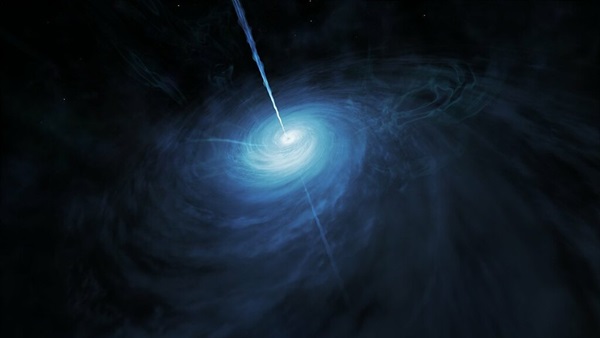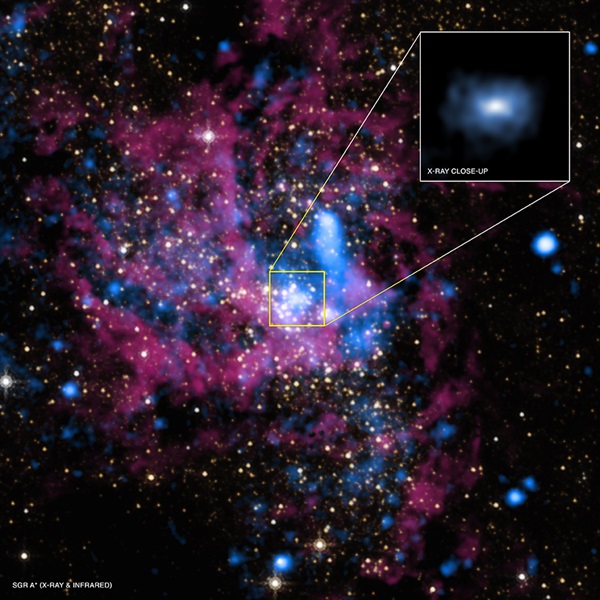Key Takeaways:
Black holes are, by definition, places where gravity is so strong, not even light can escape. So, they’re black — dark — and impossible to image. Right?
As evidenced by the Event Horizon Telescope’s success, we can image black holes. But what these images are showing is the shadow of the black hole against a brighter background. The light you see isn’t coming from the black hole itself, but from a region around it called the accretion disk. This is a disk-shaped structure of material falling inward, pulled toward its doom by the black hole’s gravity. Once it crosses the event horizon, or the point of no return, it disappears from view. But outside the event horizon, we can still see it — and any light it gives off.
Building an accretion disk
Why is there a disk at all? Can’t all the infalling stuff just all smoosh into the black hole at once? It can’t! Because everything in the universe has its own momentum (specifically, angular momentum), it can’t just fall directly into the gaping maw of a black hole. Instead, it must lose that momentum first, and it does so by swirling into a disk, getting closer and closer until it finally crosses the event horizon and disappears.
The physics behind this is complex, but the simplified story is that accretion disks transfer angular momentum from their inner regions to their outer regions through processes such as turbulence and friction. Essentially, as material swirls closer to the black hole, it bumps into and rubs up against more material already in the disk. This both slows down the infalling material and generates heat. And when things get hot (here, we’re taking about tens of millions of degrees), they shine.
And astronomers are real pros at looking for things that shine.
We see light from accretion disks across a broad swath of the electromagnetic spectrum. X-rays or visible light typically come from the hot disk itself. What’s more, light that comes directly from the accretion disk isn’t constant. It changes, flickering over timescales that can range from minutes and hours for small, stellar-mass black holes to weeks or months for the supermassive black holes that sit at the centers of galaxies. This flickering is random and researchers suspect it may be due to processes within the disk, such as regions of higher turbulence or even clumps of matter getting close to or falling into the black hole.
The rate of variability — although still random — does scale with the black hole’s mass. More massive black holes with bigger accretion disks change slower than those with less mass and smaller accretion disks. The Event Horizon Telescope (EHT) detected changes in the accretion disks around the supermassive black holes in M87 (the first black hole ever imaged, released in April 2019) and 3C 279 “over the course of a week,” Dan Marrone at the University of Arizona, a member of the EHT science council and data analysis working group coordinator, told Astronomy in 2019. “And since Sgr A* is 1,500 times less massive than M87, it varies that much faster. Scale a week down 1,500 times, you’re talking minutes.”
Taking a clear photo is extremely difficult when the subject you’re trying to photograph is literally changing by the minute, while you’re trying to capture it. So, when it came to getting an image of Sgr A*, Marrone said, it wasn’t necessarily a matter of getting more data. Instead, “figuring out how to deal with a source that changes while we’re looking at it is a bigger deal.”
Spotlight on Sgr A*
Sgr A* itself contains some 4.6 million solar masses within a space about 6 light-hours across (roughly the distance between Pluto and the Sun). Its accretion disk spans a region a few times that, a couple of times the diameter of our solar system. In 2019, researchers using the Atacama Large Millimeter/submillimeter Array (ALMA) announced they’d spotted this disk for the first time, glowing faintly at radio wavelengths. Sgr A*’s disk contains less mass than our Sun — some 0.00001 and 0.0001 solar masses — and the team estimated the amount of material falling into the black hole each year is a mere 10-10 solar masses (that’s less than the mass of dwarf planet Ceres).
That makes Sgr A* a pretty quiet, underfed black hole. We think, based on structures called the Fermi bubbles, that its last big meal was probably somewhere between 5 million and 9 million years ago, when it swallowed about 100 solar masses worth of material. Since then, it’s been slowly picking away at its surroundings, taking tiny bites rather than big gulps.
This is normal for older galaxies such as the Milky Way, which might still be forming stars but are relatively stable in terms of structure and star-formation rate. Where this isn’t the case is in the early universe, or where mergers — when two or more galaxies crash together — are taking place.
In these environments, the black holes at the centers of galaxies have a veritable feast at their fingertips. They are frequently actively feeding on huge quantities of gas and dust in the center of their home galaxy, and their accretion disks are so bright that they’re more easily detectable — sometimes literally by eye. In the most extreme cases, where the disk is so bright it outshines all the other glowing stars and gas in the galaxy, we see what astronomers call a quasar. These objects are distant galaxies that appear starlike because all the light we can see from them is coming from a tiny region in the center, blazing so brightly we can’t make out the stars, dust, and gas around it.
Getting a good photo requires the right background light. Without accretion, black holes become truly stealthy, requiring astronomers to use other, often trickier, methods to detect them. It is only thanks to the final hurrah of doomed stars, gas, and dust that the invisible becomes visible: the dark blot of a black hole, shadowed against the bright, circular background of its accretion disk.











